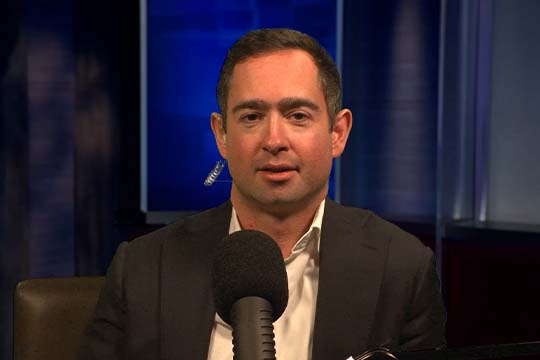A stronger-than-expected jobs report could reshape the path of the ongoing US equity rally, prompting investors to reassess risk, policy expectations, and sector leadership. In a discussion set against this backdrop, Rich Privorotsky, the head of European One Delta trading in Goldman Sachs Global Banking & Markets, sits down with Chris Hussey to unpack what the fresh labor data means for traders, portfolios, and market sentiment. The conversation was recorded on June 6, 2025, capturing a moment when the labor market’s surprise strength was reverberating through equity markets, currency moves, and fixed-income dynamics. This interview aims to translate complex market signals into practical insights for investors weighing the next leg of the rally and how a robust payrolls print could influence asset allocation and risk tolerance.
The macro backdrop: how a stronger jobs report interacts with the US equity rally
The release of a stronger-than-expected jobs report often serves as a pivotal data point that can recalibrate expectations for growth, inflation, and monetary policy. When payroll gains outperform forecasts, investors must weigh the implications for the pace of economic expansion versus the persistence of price pressures. A robust labor market reinforces the narrative of ongoing demand resilience, supporting consumer spending and corporate earnings potential, even if wage growth remains a point of contention for policymakers. In the context of the current US equity rally, this dynamic can have a twofold effect: it can sustain momentum by validating a constructive growth outlook, or it can introduce shifts in rate expectations that might alter equity valuations, sector leadership, and sector inflation sensitivities.
From a trader’s perspective, the jobs data can influence risk appetite in nuanced ways. If the payrolls surprise is broad in scope—employment gains across multiple sectors and a robust labor participation rate—it can bolster confidence that the economy is navigating a soft landing or even a resilient expansion. This scenario tends to support cyclical equities, such as technology, industrials, and energy, which often benefit from higher economic activity and improved earnings visibility. Conversely, if the strength in employment is coupled with stubborn wage growth or signs of inflationary persistence, investors may reassess the timing and magnitude of monetary policy normalization. In such cases, fixed-income markets might reprice more aggressively, elevating yields and causing rotational moves away from rate-sensitive equities into value-oriented or defensive segments.
The interplay between the labor market and the broader macro environment is crucial for pricing across assets. Equity risk premia can tighten as investors seek to discount improved growth prospects, while discount rates in equities may rise if the market anticipates higher interest rates or prolonged monetary accommodation. The resulting market dynamics often lead to a reallocation of capital toward sectors that benefit most from strengthening demand and constructive policy signals, alongside a careful evaluation of inflation trajectories. For investors, the central question remains: does the stronger jobs data justify extending the current rally or does it prompt a more cautious stance as policy uncertainty persists?
In this context, the discussion with Rich Privorotsky probes how a trader on the European One Delta desk at Goldman Sachs Global Banking & Markets interprets the message from payrolls data and translates it into actionable strategy. The conversation centers on whether the jobs report provides a clear invitation for investors to chase the US equity rally or whether the data merely reinforces existing expectations and the need for selective exposure. Across the trading floor, the emphasis is on differentiating signals that indicate sustainable growth from temporary blips, and on managing risk as volatility and liquidity conditions evolve in response to the labor market’s latest data point. The June 6, 2025 recording captures a moment when market participants were reevaluating the durability of the rally against the backdrop of a labor market showing unexpected vigor, prompting a reassessment of timing, sectors, and hedging approaches.
The role of central banks and policy expectations
A stronger jobs report can influence expectations for central bank policy by impacting perceived inflation dynamics and growth trajectories. If payrolls are stronger than anticipated, traders may reassess the trajectory of future rate moves, the pace of balance sheet normalization, and the likely cadence of policy communications. In this environment, market participants scrutinize whether the labor market strength translates into persistent price pressures or whether labor market slack remains sufficient to keep inflation on a slower, more manageable path. The interaction between labor market data and central bank signaling often dictates shifts in yield curves, currency valuations, and risk premia embedded in equities. For a trading desk like European One Delta, this means calibrating trades to capture potential divergence in interest rate expectations between the US and other major markets, while also considering the hedging implications of higher yields on equity valuations.
The interview with Privorotsky delves into how a robust jobs print might alter the balance of risk-on versus risk-off trades in a cross-asset framework. Traders must assess not only the immediate equity price response but also the second-order effects: how bond yields react, how the US dollar reacts to rate expectations, and how global liquidity conditions adjust to a recalibrated outlook for growth and inflation. This multi-asset perspective is essential for identifying which parts of the US equity rally could remain resilient in the face of tighter or more uncertain monetary policy signals, and which segments may require tactical hedges or rotation into more defensive exposures.
Investor behavior and market psychology
Beyond the numbers, investor sentiment plays a critical role in determining the persistence of a rally. A stronger jobs report can reinforce conviction in a constructive growth scenario, but it can also trigger caution if it heightens concerns about policy normalization or if it amplifies fears of a steeper yield curve. Behavioral dynamics—such as herding in momentum trades, fear of missing out (FOMO) during a rally, or a renewed emphasis on downside risk protection—shape day-to-day trading activity and longer-term investment decisions. The discussion with Privorotsky emphasizes that the psychology of markets often interacts with objective data to create patterns of flow and positioning that traders monitor closely. In practice, this means watching for shifts in sector leadership, the emergence of new leadership groups within the market, and the speed at which funds rotate in and out of equities en masse.
The June recording captures a snapshot of how a senior trading executive interprets payrolls news through the lens of the One Delta desk, balancing the expectations of European clients and global market participants with the realities of US macro data. The goal is to translate a macro surprise into a tactical framework that can be executed on a global trading platform, ensuring that the desk’s positioning remains agile amid evolving data, policy signals, and risk sentiment. As the narrative unfolds, investors are reminded that a single data release often triggers a cascade of market moves across asset classes, requiring a disciplined approach to risk management, diversification, and strategic exposure.
Perspective from Rich Privorotsky: European One Delta trading at Goldman Sachs
Rich Privorotsky occupies a pivotal role within Goldman Sachs Global Banking & Markets, serving as the head of European One Delta trading. This position places him at the intersection of multiple market dynamics: cross-asset liquidity management, complex derivatives strategies, and the execution of large, nimble trades across European and global markets. One Delta trading desks are known for their emphasis on rapid response strategies and multi-asset hedging capabilities, enabling traders to navigate volatility, liquidity gaps, and shifting correlations with a keen emphasis on preserving capital while pursuing incremental upside. Privorotsky’s leadership in this space suggests a focus on translating macro signals—such as a stronger-than-expected jobs report—into tactical recommendations that align with client objectives and risk tolerance.
In the context of the June 6, 2025 discussion, Privorotsky’s perspective would likely center on how to interpret an unexpectedly strong payrolls figure through the lens of a European trading franchise within a leading global investment bank. The dialogue with Chris Hussey would explore the practical implications for cross-border flows, currency dynamics, and the relative attractiveness of US equities in a world where rate expectations may shift in response to labor data. From a trader’s standpoint, a stronger jobs print can trigger a confluence of forces: higher US yields, potential dollar strength, and a rebalancing of equity exposures to reflect revised growth and inflation expectations. Privorotsky would be expected to emphasize disciplined risk management practices, liquidity considerations, and the importance of diversified hedges when positioning for potential changes in the monetary policy outlook.
Trading framework and risk management considerations
In an environment shaped by a robust jobs report, the trading framework on a desk like One Delta would involve a structured approach to risk management and position sizing. Traders would evaluate the probability distribution of outcomes for equities, currencies, and rates under varying assumptions about inflation persistence and policy normalization. Hedging strategies, including options overlays or dynamic delta hedges on equity indices and sector baskets, would be employed to manage exposure to volatility spikes and abrupt regime shifts. The goal is to maintain portfolio resilience while remaining nimble enough to capitalize on legitimate trend continuations prompted by the data. The interview would likely touch on practical aspects of implementing these strategies, such as how to calibrate strike selection for options, how to time hedges in response to intraday moves, and how to manage collateral and funding costs in a volatile environment.
On the client-side perspective, Privorotsky’s team would be mindful of the needs of European investors who are exposed to US macro developments. The cross-border nature of One Delta trading implies that currency movements, regulatory considerations, and regional risk appetites can significantly influence trade execution and performance. The conversation with Hussey would therefore explore how these factors shape the desk’s recommendations for client portfolios, particularly in times when the US labor market delivers surprises that ripple through global markets. In practice, this means balancing the desire to participate in or front-run the rally with the imperative to protect profits and minimize drawdowns in the event of a sharp policy pivot or a sudden escalation in volatility.
Case framing: translating payrolls into actionable ideas
If the jobs data comes in stronger than anticipated, Privorotsky and his team might focus on several actionable ideas. These could include fine-tuning allocations toward sectors that historically benefit from firm growth and higher rates, such as technology hardware, semiconductors, and industrials, while also considering the potential for value and cyclicals to take the baton in a continued economic upswing. They could also explore hedges against a steeper yield curve or currency hedges to manage dollar exposure, depending on how the data influences the relative attractiveness of US versus European assets. The ability to execute these ideas in a high-liquidity, multi-asset environment requires a robust risk framework, real-time analytics, and a deep understanding of how cross-asset correlations behave under the stress of a strong payrolls surprise.
Implications for US equities across sectors and asset classes
A stronger-than-expected jobs report often reshapes the sectoral leadership within the US equity complex. Growth-oriented tech names may benefit from a stronger growth impulse and higher earnings expectations, while industrials and energy sectors might gain from optimism about activity levels and commodity demand. However, the exact rotation depends on several intertwined factors, including inflation signals, wage dynamics, and the central bank’s assessment of how quickly it should tighten policy. Investors watch how robust payrolls interact with other data points—such as consumer spending trends, manufacturing activity, and services-sector surveys—to form a holistic view of macro momentum.
Within the US equity market, valuation sensitivity to interest rates becomes a key driver of price action. If a stronger jobs report leads to higher yields or a steeper yield curve, growth stocks with high valuations could face headwinds, while cyclicals and value-oriented plays could outperform as discount rates rise more gradually for earnings that are perceived as more resilient in a rising-growth environment. The balance between growth and value cycles may tilt in favor of sectors that are well-positioned to benefit from capital expenditure cycles, improved productivity, and stronger demand catalysts.
From an asset-allocation perspective, the data point can influence how institutional and retail investors position across equity styles, market caps, and geographies. A healthy payrolls print may encourage more aggressive risk-taking in equities for some, particularly if accompanied by signs that inflation remains contained and the economy can absorb higher rates without derailing growth. Others may adopt a more selective approach, favoring quality stocks with durable earnings, strong balance sheets, and greater cash flow resilience, while reducing exposure to parts of the market that exhibit higher sensitivity to cyclical turnarounds or to policy surprises.
Sector-specific considerations
- Technology and software: These sectors can benefit from continued demand for digital transformation, cloud computing, and AI-driven productivity enhancements. If payroll strength translates into sustained demand growth, tech equities may extend gains as investors discount higher earnings multiples into a pro-growth macro environment.
- Industrials and materials: A robust job market often signals amplification of economic activity, which can support industrials, capital goods, and materials sectors tied to infrastructure and manufacturing cycles. Investors watch for signals of capex acceleration and improved supply-chain normalization that could fuel earnings improvements.
- Energy: Higher activity expectations can lift energy demand outlooks, supporting energy equities. However, price dynamics for oil and gas depend on a broader mix of supply constraints, global demand, and geopolitical factors, making energy trades sensitive to policy, OPEC decisions, and technological shifts in energy efficiency.
- Financials: A stronger labor market can bolster consumer confidence and loan demand, benefiting banks and other financial services firms. Yet if rates move aggressively higher in response to inflation or policy expectations, financials may face a balancing act between net interest margins and credit risk.
Cross-asset considerations
- Fixed income: The impact of payroll surprises on bond markets hinges on the anticipated path of interest rates. A stronger jobs report raising concerns about inflation could push yields higher and steepen curves, while signs of cooling inflation might limit rate increases and support bond prices in some segments.
- Currencies: A tight labor market can influence currency dynamics by shaping expectations for the Federal Reserve’s policy path. A stronger dollar scenario can place pressure on multinational earnings and impact cross-border investment strategies, requiring currency hedges to mitigate translating effects on profits.
- Commodities: If a robust jobs print signals stronger activity, commodity demand can pick up, benefiting sectors tied to energy, metals, and agriculture. Traders may monitor commodity inventories, production costs, and global demand to gauge the sustainability of price trends.
Risks, uncertainties, and policy considerations
Despite the favorable implications of a stronger jobs report for growth narratives, several risks warrant careful attention. Wage growth, productivity gains, and inflation persistence remain central to determining how policymakers may adjust monetary policy. If wages accelerate alongside payroll gains, inflation could become more stubborn, prompting a tighter policy stance and potential upside pressure on yields. This scenario could create volatility in equity markets, especially for high-valuation equities whose prices are sensitive to discount-rate assumptions.
Policy uncertainty continues to be a critical consideration for investors. The pace and sequencing of policy normalization, trade considerations, and macro policy alignment across major economies influence market expectations and risk sentiment. Market participants must monitor central bank communications for hints about the balance between combating inflation and supporting growth. Even with a strong labor market, clear signals about the trajectory of rate cuts or reductions in asset purchases can shape how investors position themselves in the near term and beyond.
Liquidity conditions and market structure are additional sources of risk. In a world of higher yields or shifting volatility regimes, liquidity may become more episodic, with wider bid-ask spreads and more pronounced price moves during times of data release or policy announcements. Trading desks must manage these risks while seeking to capitalize on persistent themes and mispricings that arise from the confluence of payroll data, policy expectations, and macro surprises.
Investor exposure to US equities is also shaped by global macro developments. Developments in Europe, Asia, and other regions influence cross-border investment flows and currency dynamics that affect relative performance. The interview with Privorotsky highlights the importance of an integrated view that accounts for global liquidity, cross-asset correlations, and the interplay between domestic data and international market conditions. As data evolves, investors may adjust exposures to balance growth prospects with risk controls, blending tactical moves with longer-term strategic allocations.
Scenario planning and portfolio positioning
- Base case: Payrolls surprise remains constructive for growth with contained inflation, supporting a gradual path of rate normalization. Equities see continued resilience with selective leadership in sectors tied to productivity and innovation.
- Upside risk: Stronger growth and inflation persistence push rate expectations higher, triggering a more pronounced rotation into value, financials, and defensives with inflation hedges.
- Downside risk: Softening wage growth, cooling inflation, or signs of a policy pivot could trigger a rapid shift toward growth stocks, tech leadership, and higher liquidity in risk assets as investors reassess the pace of normalization.
- Hedging framework: Dynamic options strategies, sector hedges, and currency overlays to manage cross-asset risk and protect against abrupt regime changes.
Market structure, liquidity, and investor behavior in a stronger data environment
When payrolls exceed expectations, markets often experience a cascade of liquidity and behavior shifts. Increased volatility can present both opportunities and hazards for institutions and retail participants. The trading environment becomes more dynamic as liquidity providers adjust to the evolving risk landscape, and as retail investors react to headlines and expert commentary. On the One Delta trading desk, such dynamics require a robust framework for continuous assessment of liquidity, bid-ask spreads, and the availability of hedges across asset classes.
Investor behavior tends to become more momentum-driven during strong rallies, with a higher propensity to chase performance and increase exposure to sectors exhibiting accelerating earnings momentum. However, this behavior can also invite sharp pullbacks if data surprises provoke unexpected policy pivots or if liquidity tightens during stress periods. The discussion with Privorotsky would likely emphasize the importance of disciplined risk management and the use of diversified strategies to navigate these conditions. Traders must remain agile, but not impulsive, ensuring that strategies align with the broader risk framework and client objectives.
Liquidity dynamics are also influenced by cross-border flows and currency interdependencies. In a European context, movements in the US dollar and cross-currency basis can impact funding costs, hedging efficiency, and the profitability of cross-asset trades. The interview would address how the One Delta desk manages these considerations, balancing the need for fast execution with the imperative to control funding and capital costs in a volatile environment. The ability to withstand adverse liquidity shocks hinges on meticulous sequencing of trades, robust risk controls, and a clear understanding of counterparties’ risk profiles.
Conclusion
The conversation surrounding a stronger-than-expected jobs report and the US equity rally centers on how labor-market resilience translates into macro certainty and market-moving policy expectations. Rich Privorotsky, as the head of European One Delta trading at Goldman Sachs Global Banking & Markets, provides a vantage point focused on cross-asset execution, liquidity management, and risk-aware strategy within a complex, evolving market ecosystem. The June 6, 2025 recording captures a moment when traders and investors grapple with the signals from payroll data, weighing the potential for continued rally against the possibility of policy normalization and volatility shifts. Across sectors, assets, and geographies, the central theme remains clear: data-driven insights, disciplined risk management, and adaptive positioning are essential to navigate an environment where a single labor-market surprise can reframe the trajectory of markets. Investors will continue to watch how the stronger jobs data interacts with inflation, policy signals, and global dynamics as they seek to find the balance between participation in the rally and prudent protection of gains.



